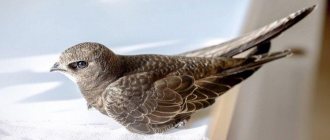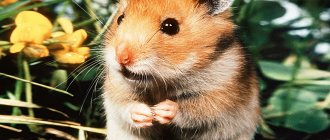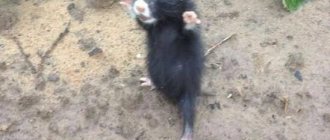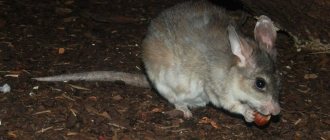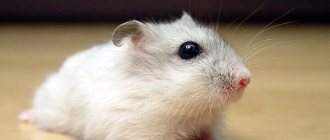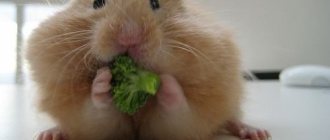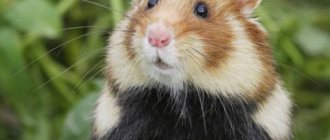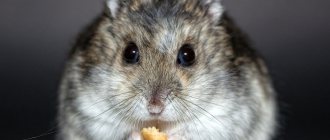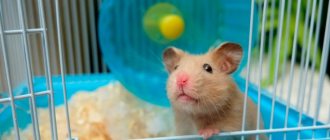The steppe hamster (common) is a large self-spreading rodent species that has virtually nothing in common with domestic pets. It is distinguished by small ears, well-developed toes, and is excellent at digging holes and doing other things. But the most important thing is that he is able to live independently; he not only does not need human help, the hamster will aggressively accept it. Sometimes it is much safer to meet a snake or a poisonous spider than this wild and vicious rodent.
Description of the species
You can see quite a lot of features at one glance at such a rodent as the steppe hamster. The description of its appearance is as follows:
- stocky body with a thick head and short neck;
- small ears, shiny and relatively huge eyes;
- short paws with well-developed toes and short claws.
The fur of this animal includes two elements: the base and the undercoat. Thanks to the latter, the hamster can easily endure winters and sub-zero temperatures. The color is usually light yellow or brown. Dark and black spots are common.
A characteristic feature is that hamsters have white feet. But the front and hind limbs are black on the inside.
But this does not mean that you will not be able to meet a steppe hamster, which will have a completely different color. Sometimes you can see completely white or, on the contrary, completely black representatives of the family.
Separately, it is necessary to say about the sizes. Males reach a length of 34 cm excluding the tail. The latter can reach up to 5 cm in length.
Are there fundamental differences between wild and domesticated individuals?
Domestic and wild rodents have similar body structures, but the animals differ greatly in size. Karbysh is much larger and heavier. The ears of wild species are more massive and clearly visible on the head. The color of the animals is also different; pets often have a beige, golden or white coat. In wild relatives, the body is covered with brown fur with large black and light spots.
The nature of the animals also varies greatly. Pets are calm, peaceful animals. They get used to the presence of a person and allow themselves to be picked up.
Wild individuals are unpredictable and aggressive. They do not tolerate proximity to other animals. A field hamster can bite a person; picking it up is dangerous. This is a wild animal that is very difficult to tame.
Distribution area
The steppe hamster is distributed over quite wide areas. It lives in lands from Europe to China. In particular, in Russia it can be found in the open spaces from Smolensk to the southern taiga.
This hamster does not require any special living conditions, which is why it can live virtually anywhere. For the most part, animals are found near grain and wheat fields. Some individuals dig their burrows directly on these arable lands. The rest prefer to live closer to people. They settle near villages and hamlets. The food consists of various products from the garden.
It is not uncommon for hamsters to visit barns and storerooms. Like house mice, they carry supplies into their burrows. But, unlike them, hamsters are much more dangerous, as they are aggressive against humans. Therefore, it is necessary to set traps if such a “neighborhood” is suddenly noticed.
Habitat
The wild hamster is distributed almost everywhere. The habitat of the carbysh covers the Caucasus, Siberia, Altai and the Crimean Peninsula. The hamster is found in Kazakhstan, China and many European countries.
Previously, the animal lived in the steppe, forest-steppe and mixed-grass meadows. But due to large-scale deforestation, the rodent's distribution area has expanded significantly. The wild hamster successfully colonizes gardens, fields, orchards and summer cottages. And if there is a lack of food, the animal can settle in living quarters.
On a note. A wild hamster alone is capable of destroying the lion's share of the crop. Therefore, in dachas you need to pay attention to signs of the presence of a pest. The steppe rodent leaves characteristic marks, digs at the roots of carrots and potatoes, and also eats the bark at the very bottom of trees.
Hamster hole
The steppe hamster spends most of its life in a burrow. This is not at all due to the fact that he is afraid to leave the confines of his home. The animal is quite fearless. But to hunt, he needs a lot of rest.
The hamster hole goes 1-2 meters deep into the earth. It all depends on how easy it is to dig the soil. The basis of the house consists of:
- living chamber;
- inclined exit;
- steep entrance.
The living chamber, in turn, has three “doors”. The first two are intended to ensure that the animal can freely enter home and leave if necessary. And the third door is oriented to the room with supplies. Only in winter and early spring does the hamster use products from there; on other days its diet consists of fresh grains, vegetables and fruits.
How to identify a hamster? You can do this based on characteristic buildings. They are easily recognized by small piles of earth located directly near the inlet/outlet. They are sprinkled with grain husks on top.
Using a small stick, you can find out whether a rodent lives in the found hole. It needs to be placed inside and then pulled out. If cobwebs, moss, husks or grass are found on it, then the dwelling is abandoned. No hamster would keep his house in disarray.
Feeding the steppe hamster
What does a hamster eat? It is impossible to specify this moment in any way. Everything directly depends on the place where he lives. If its habitat is focused on places near grain fields, then it will feed mostly on grain crops. At the same time, its harm to agriculture will be minimal. Moreover, often during their trips for supplies, hamsters eat small insects and animals, which makes it easier for humans to get rid of them.
If the animal has settled near a village, then the basis of its diet will be vegetables and those crops that are most popular in the region. But they cannot be collected as supplies for the winter, so hamsters have to destroy people's warehouses and barns to find grains.
It is not uncommon for hungry animals to attack chickens, especially if there is no chicken nearby to protect them or at least make some noise.
Hibernation
A wild hamster is susceptible to hibernation, since it has no other option other than a slow metabolism to endure harsh weather conditions. He begins to wake up when the earth freezes. This usually happens in February, sometimes a little later.
A notable feature is that the hamster will not immediately open its entrances and exits. First, he will sit in the hole for some time, eating up the remaining supplies, and only after a month the holes will be open.
Females come out later, closer to mating time.
First, after hibernation, animals begin to eat seeds and grains that they find in the fields. Then they proceed to the young shoots. But at any time after hibernation, hamsters are ready to feast on meat. They will not hunt on their own; their diet will be varied only if they encounter a weak or wounded animal along the way.
Character
The hamster is the most aggressive and evil rodent. If other species of its family prefer not to appear in front of humans, then this one will rush into battle at the first opportunity. Moreover, these animals rush at dogs that are several times larger than themselves.
Even if you look at what a hamster eats, you can immediately recognize its evil character. For example, if a male meets a female not during mating, he will bite her to death. If, during the mating process itself, several contenders line up for the process, then the weaker ones rarely manage to survive.
It is impossible not to note the love of animals for territorial division. Males can control land up to 12 hectares, females - a little less. If another animal enters the territory of one hamster, a fight ensues. Moreover, the owner of the land will defend himself as zealously as possible.
Thus, a meeting with a steppe hamster does not bode well. The only way to make a good pet out of him is to bring a very small individual into the house, which will not know how its relatives live.
Is it a protected animal?
In recent years, the hamster population has declined sharply. Scientists attribute this to a decrease in female fertility. Previously, the litter consisted of 10-12 cubs. Now their number has decreased to 3-6 individuals. This is due to the active use of pesticides by humans in agriculture.
Until the middle of the 20th century. In Europe and the USSR, animals were hunted for their fur. Massive fishing and the active use of pesticides in agriculture have also led to a reduction in the number of rodents.
In some European countries, the wild hamster is on the verge of extinction. In France, Belgium, Poland, and Germany, rodents are protected. Measures are being taken to restore the animal population. A decrease in the number of rodents has been recorded in Russia. In 5 constituent entities of the Russian Federation, the hamster received conservation status. Animals are protected in Tatarstan, Tambov, Nizhny Novgorod, Penza and Lipetsk regions.
In some countries the hamster is on the verge of extinction.
Reproduction of hamsters
At the end of May, when 4-5 weeks have passed since mating, the female goes to her nest. There, 6-18 cubs can be born. At first the babies will be bald and blind, but each of them already has teeth. Children grow quickly, literally on the 3rd day the first fluff appears. After a week, they open their eyes and slowly crawl around the nest, getting used to exploring the world.
The steppe hamster shows its loyalty only during mating and raising offspring. Males guard several territories of females. This is done so that in case of defeat in a fight with an enemy, there is an opportunity to continue the race with another female. Mothers treat their babies lovingly. Moreover, they will even accept other cubs for feeding, regardless of their age. But kids may have a negative attitude towards new neighbors. If the decoy child is smaller, he will most likely be run over.
Catching steppe hamsters
Steppe hamsters reproduce quickly in nature. They cannot be called an endangered species, although in many reserves their life is strictly protected. For this reason, some regions of Russia are engaged in “hamster” fishing.
Animals are caught in spring and autumn. This is done until molting occurs. Moreover, if during fights, which is often observed among hamsters, the skin was damaged, then the animal is released into the wild.
Animals are caught in special traps. They are installed next to the hole, digging in a little. Such devices may slightly damage the limbs, but not the skin. After setting the trap, water is poured into the hole. The animal can only be saved if it went for supplies at that time.
The skins are used in the clothing industry. Some hunters eat meat that is said to resemble squirrel. It is considered very tasty, and most importantly – nutritious.
Lifestyle
Hamsters are nocturnal animals, and therefore their activity time is late at night, sometimes early in the morning. During the day, these animals sit in burrows and will leave their shelter only in case of imminent danger. They lead a solitary lifestyle and, despite their small size, zealously defend their territory from the encroachments of other rodents.
Males are friendly to females only during the mating period. The rest of the time they do not show attention, but they can also be aggressive when it comes to survival or the fight for food.
Information in the encyclopedia talks about the increased aggressiveness of animals. They can attack a person for no reason simply from a hole. Such situations especially occur in the fall, when the animal is preparing supplies for the winter. Hamsters' teeth are small and very sharp, and therefore the bites leave deep, with severe pain. The wound may be infectious, so urgent disinfection or hospitalization is required.
Steppe hamsters often attack other animals. The size, weight and appearance of the enemy are not important; the speed and sharp teeth of this rodent can put even a fox or wolf to flight.
Interesting facts from the life of steppe hamsters
There is no more unique animal than the steppe hamster. Interesting facts from the life of this rodent are often found. For example, biologists were very surprised by their great love and ability to swim. In the process, the animal inflates the bags that are located in the cheeks (where it also places supplies), and floats freely.
When talking about what a hamster eats, one cannot lose sight of its poaching activities. There have been cases when these animals attacked rabbits listed in the Red Book, gnawed their necks and calmly feasted on the meat.
Because hamsters are very aggressive, they have many enemies. And this is good for the person. The fact is that if you do not engage in extermination, which birds of prey are excellent at, the population will become too large. But on some lands, people have to work independently in order to clear the territories.
In conclusion, it must be said that there are many features that a hamster has. The steppes and forest-steppe territories received an excellent unique inhabitant, despite all his aggressiveness and viciousness.
Harm to a person - a farmer
Karbysh often settle near fields, dachas, and farms. With large populations, they are capable of causing great damage to crops. Everything that a rodent finds in the field is edible for it.
It is easy to detect the presence of a rodent: you can see teeth marks on fruits and vegetables, bark has been eaten at the bottom of trees and bushes. Traces of digging are visible on plantings of potatoes, carrots and other root crops.
Hamsters reproduce exponentially. If no measures are taken, they will fill all the fields with their holes.
Hamsters bring not only harm, but also benefit, destroying beetle larvae in the fields, eating insect pests, including locusts, which cause enormous damage to farmers.
